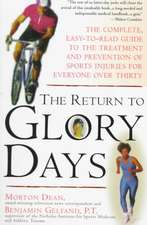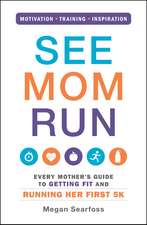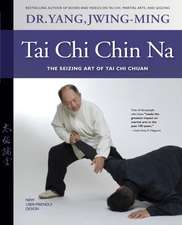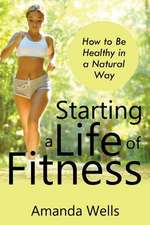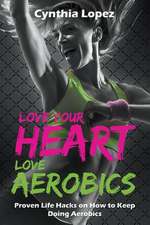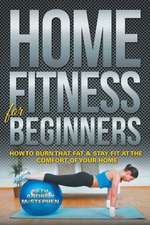The Complete Book Of Running For Women
Autor Claire Kowalchiken Limba Engleză Paperback – 18 sep 2000
Preț: 72.63 lei
Nou
Puncte Express: 109
Preț estimativ în valută:
13.90€ • 14.55$ • 11.50£
13.90€ • 14.55$ • 11.50£
Carte disponibilă
Livrare economică 21 martie-02 aprilie
Preluare comenzi: 021 569.72.76
Specificații
ISBN-13: 9780671017033
ISBN-10: 0671017039
Pagini: 416
Dimensiuni: 156 x 235 x 41 mm
Greutate: 0.61 kg
Ediția:Reissue
Editura: Gallery Books
Colecția Gallery Books
Locul publicării:United States
ISBN-10: 0671017039
Pagini: 416
Dimensiuni: 156 x 235 x 41 mm
Greutate: 0.61 kg
Ediția:Reissue
Editura: Gallery Books
Colecția Gallery Books
Locul publicării:United States
Notă biografică
Claire Kowalchik is the author of The Complete Book of Running for Women, Rodale’s Illustrated Encyclopedia of Herbs, Runner’s World Running on Air, and Running Strong.
Extras
Chapter One: Running for the Body
Better to hunt in fields, for health unbought,
Than fee the doctor for a nauseous draught.
The wise, for cure, on exercise depend;
God never made his work for man to mend.
-- John Dryden, Epistle to John Driden of Chesterton (1700)
Why take up running? Because it is the simplest, fastest, most accessible way to fitness and good health known to woman. You don't need a partner; you don't need equipment, a court, or a gym; and you don't need much time. A mere 20 minutes three or four times a week is enough to make you fit, although most of us find that 20 minutes isn't enough to satisfy our desire to run.
Those who say they haven't time for running are simply making excuses. The morning, before the family wakes or work begins, is free time for most of us. If not, how about during your lunch hour or after you come home from the office? Just 20 minutes. It might seem difficult at first -- even the slightest changes in routine can take some getting used to -- but before you know it, you'll be figuring out ways to find 30 minutes, 40 minutes...an hour for running.
Then there are others who say running is just too hard, too painful. They wrinkle up their noses at the mere thought of it. Running is hard, but that's one of the reasons we love it. We feel special as runners because we can endure. Besides, running gets easier. The reason many people say it's painful is because they go out for their first run and virtually sprint for as long as they can -- which isn't very long -- with their chest heaving, their tongues lolling, their muscles straining until finally they can go no farther. They stop and pant, hands on their hips, wobbly kneed. "I -- gasp -- hate -- gasp -- running," they say.
So would I if I ran like that every day. Running is not an act of will over body -- the brain whipping the legs to go as fast as they can as long they can (except when you really are sprinting). When you're running, your mind and body work in tandem toward an enjoyable continuum of movement over the ground. In the beginning, when your body is not yet capable of blazing speeds, your mind should say, Okay, slow down. Let's go at a pace that's comfortable for you.
Now that you don't have any excuses not to start, here are several reasons to begin running if you haven't already and to continue running if you have.
Running Is the Quickest and Most Efficient Means of Weight Loss
Let's compare running to another popular and convenient fitness activity -- walking. In 20 minutes of running at a relaxed 10-minute-per-mile pace, a 130-pound woman burns 200 calories. In 20 minutes of walking at 15 minutes per mile (a brisk pace), a 130-pound woman burns only 72 calories. Of the 200 calories burned running, roughly 100 come from fat and 100 from carbohydrates. The 20 minute walk burns 54 fat calories and 18 carbohydrate calories. Furthermore, studies show that running increases your resting metabolic rate (meaning you burn more calories even when you're not active) and improves your body composition by reducing body fat. The clear result of all of this is a leaner, trimmer figure.
Vanity aside, managing your weight is one of the most important things you can do for your health, well-being, and longevity. Obesity is a heavy contributor to heart disease, high blood pressure, stroke, breast cancer, and diabetes.
Running Reduces Your Risk of Cardiovascular Disease, the Number-One Killer of Women
In the Nurses Health Study of 73,029 women aged 40 to 65, conducted by JoAnn E. Manson, M.D., of the Brigham and Women's Hospital and Harvard Medical School in Boston, the rate of heart attack was found to be 44 percent lower among the most active women compared with those who were sedentary.
Running has several effects that lower your risk of cardiovascular disease:
High mileage seems to have the best effect on raising HDL cholesterol levels, whereas running faster is better for lowering triglycerides, according to a study by Paul T. Williams, M.D., of the Lawrence Berkeley Laboratory in California. Williams's research looked at 1,837 female runners who were grouped according to weekly mileage: 0 to 9, 10 to 19, 20 to 29, 30 to 39, and 40 or more miles. HDL cholesterol levels rose with mileage -- those in the 40-plus mileage group showing the highest levels. Also, as mileage increased, heart rate and body mass index (BMI; a calculation of weight based on height) decreased. Williams concluded that women who run 40 miles or more a week decrease their risk of dying from cardiovascular disease by 45 percent. He pointed out, however, that significant benefits are accrued at lower levels of weekly mileage as well.
Running Lowers Your Heart Rate and Blood Pressure
Williams also noted in his study that running lowered blood pressure and heart rate. Though the women who put in more weekly mileage showed the lowest figures for blood pressure and pulse, Williams found that fast running seemed to have an even greater effect -- a good reason to do speed training and take up racing.
Running Reduces Your Risk of Stroke, the Second Leading Killer of Women
Given that running helps lower blood pressure and keeps the cardiovascular system healthy, it's not surprising that it can also help prevent stroke. A study conducted by researchers at the University of Alabama at Birmingham and reported in the British Medical Journal (July 24, 1993) compared 125 men and women who had just had their first stroke with 198 men and women who had never had a stroke. In looking at the activity levels of these groups, the researchers concluded that vigorous exercise -- defined as running, swimming, cycling, and other strenuous activities -- "confers substantial protection against stroke. These effects were seen in both sexes and all age groups." The Nurses Health Study also shows that exercise prevents stroke, finding that active women have a 42 percent lower rate of stroke than do sedentary women.
Running Lowers Your Risk of Breast Cancer
For several years, health experts have suspected that physical activity may lower the risk of breast cancer, and recently a significant study reported in the New England Journal of Medicine supports this theory. Over a 13-year period, researchers in Norway studied 25,624 women aged 20 to 54. They grouped these women according to level of activity: sedentary, moderate exercisers ("those who spent at least four hours a week walking, bicycling or engaging in other types of physical activity"), and regular exercisers ("those who spent at least four hours a week exercising to keep fit and participating in recreational athletics" plus "those who engaged in regular, vigorous training or participated in competitive sports several times a week"). They found that the regular exercisers -- the most active group -- had a 37 percent lower risk of breast cancer compared with the sedentary group. The moderate exercisers showed a 7 percent lower risk.
When looking only at premenopausal women, the risks of breast cancer were even lower with physical exercise. "Our results support the idea that physical activity protects against breast cancer, particularly among premenopausal and younger postmenopausal women," the researchers concluded. The theory behind the protective effects of activity is that vigorous exercise, such as running, may suppress the secretion of estrogen and progesterone, which have been linkedto breast cancer. Also, the lower levels of triglycerides seen in physically active women reduce the amount of estrogen in the bloodstream.
Running Enhances Your Immune System
Most runners rarely get sick, and the reason is that running boosts the immune system. Researchers have determined this by measuring blood levels of lymphocytes (white blood cells that attack disease-causing antigens) and finding higher concentrations during and after exercise. It seems your body reacts to running as if a foreign invasion were occurring, and it recruits an army of lymphocytes to allay the onslaught. (During extremely long runs, however, especially those of high intensity -- such as the marathon -- so many lymphocytes are called into action that the reserves become depleted. Your immune system then becomes depressed, and you become more susceptible to illness. This is why runners often come down with a cold after a marathon. You can also wear down your immunity by running too many miles at too high an intensity in your regular training.)
Running also prevents that natural decline of immunity that occurs as we age. In 1993, David Nieman, Ph.D., and colleagues at Appalachian State University in Boone, North Carolina, compared the immune systems of active elderly women (who had been exercising aerobically for more than an hour a day for several years), sedentary elderly women, and sedentary young women aged 19 to 25. They found that the activity of T-cells and natural killer (NK) cells-two types of lymphocytes essential to immune function -- was significantly higher among the active elderly women than in the sedentary elderly group and comparable to that seen in the young women. "The T-cells of the elderly active women were functioning like those in women half their age," says Nieman. Other good news: a 1997 study of women, activity levels, and causes of death showed that those who were most active had a considerably lower risk of death from respiratory diseases than did sedentary women.
Running May Prevent Diabetes and Help Those with This Disease to Manage It More Efficiently
Running burns glucose (blood sugar) for energy, which helps prevent glucose levels from rising too high. This doesn't mean that diabetics don't still need insulin, but they may be able to use lower amounts. Running also improves circulation, which commonly deteriorates with diabetes.
Running Helps Keep Your Intestinal Tract in Good Working Order
Regular running can keep you regular. This, in combination with a diet rich in fiber, lowers your risk of colon cancer.
Running Enhances Your Respiratory System
When you run, your muscles require a quick delivery of oxygen. The more you run, the more efficient your respiratory system becomes and the easier breathing is. Though running can stimulate an asthma attack in runners who suffer from exercise-induced asthma, the fitter you become through running the less frequently you should experience such episodes. Some women have reported that running has enabled them to cut back on their use of asthma medications.
Running May Reduce the Symptoms of Premenstrual Syndrome
Scientists have no proof that exercise relieves the pains of premenstrual syndrome (PMS), but many women report that even though they may not feel like running when their period hits and they're bloated and suffering cramps, once they go for a run, they feel much better. If physical symptoms don't subside, the moodiness -- irritability or depression -- that some women experience may dissipate after a good run.
Running Improves Your Health and Well-Being During Pregnancy
We now know that most women can continue running safely during pregnancy. Those who do gain less unnecessary weight, sleep better, have better appetites, and generally enjoy better moods than do women who are sedentary. Running may also help prevent gestational diabetes and may contribute to shorter or easier deliveries, although not all runners can attest to this.
Running May Reduce the Symptoms of Menopause
When you've stepped beyond your childbearing years, you may find that running eases the discomforts of menopause by improving sleep patterns and stabilizing erratic moods that often accompany this period of changing hormones. It also helps control weight gain associated with this time of life.
Running Prevents Muscle and Bone Loss That Occur with Age
Running keeps the muscles of your legs in good shape as you age, but you'll need to do some regular weight training to maintain strength in your upper body. As for your bones, the forces that running exerts on your skeletal system stimulate bone formation and increase density. The effects are greatest in the legs, hips, and spine, the latter two areas being the most common sites of osteoporosis and fracture later in life. You can use resistance training (weight lifting) to build the bones of your upper body.
Running Is Good for Your Joints
Contrary to what most people believe, regular running does not ruin your joints; rather, it improves their flexibility and range of motion. "Running doesn't cause arthritis; injury does," says Warren Scott, M.D., chief of sports medicine at Kaiser Permanente Medical Center in Santa Clara, California. "Exercise is good for osteoarthritis. It speeds the rate at which cartilage is replaced by your body, making it stronger."
Running Helps Prevent a Decline in Reaction Time
Regular exercise has been shown to keep your mind sharp and reaction time quick. As you get older, quick reactions, good muscle tone, and overall flexibility help prevent accidents, such as falls.
Running Leads to a Long and Happy Life
That running can help you live longer and feel happier comes as no surprise, since running helps prevent heart disease, stroke, cancer, diabetes, and osteoporosis and strengthens your immune system. In a study reported in the Journal of the American Medical Association (April 23/30, 1997), Lawrence Kushi, Sc.D., and his colleagues at the University of Minnesota School of Public Health looked at a group of 40,417 postmenopausal women between the ages of 55 and 69. They found that the most active women showed a 30 percent lower risk of death from all causes compared with those who were least active. Add to that the physical strength and emotional well-being that running gives us, and we can look forward to a vibrant and happy, long life.
Copyright © 1999 by Claire Kowalchik
Better to hunt in fields, for health unbought,
Than fee the doctor for a nauseous draught.
The wise, for cure, on exercise depend;
God never made his work for man to mend.
-- John Dryden, Epistle to John Driden of Chesterton (1700)
Why take up running? Because it is the simplest, fastest, most accessible way to fitness and good health known to woman. You don't need a partner; you don't need equipment, a court, or a gym; and you don't need much time. A mere 20 minutes three or four times a week is enough to make you fit, although most of us find that 20 minutes isn't enough to satisfy our desire to run.
Those who say they haven't time for running are simply making excuses. The morning, before the family wakes or work begins, is free time for most of us. If not, how about during your lunch hour or after you come home from the office? Just 20 minutes. It might seem difficult at first -- even the slightest changes in routine can take some getting used to -- but before you know it, you'll be figuring out ways to find 30 minutes, 40 minutes...an hour for running.
Then there are others who say running is just too hard, too painful. They wrinkle up their noses at the mere thought of it. Running is hard, but that's one of the reasons we love it. We feel special as runners because we can endure. Besides, running gets easier. The reason many people say it's painful is because they go out for their first run and virtually sprint for as long as they can -- which isn't very long -- with their chest heaving, their tongues lolling, their muscles straining until finally they can go no farther. They stop and pant, hands on their hips, wobbly kneed. "I -- gasp -- hate -- gasp -- running," they say.
So would I if I ran like that every day. Running is not an act of will over body -- the brain whipping the legs to go as fast as they can as long they can (except when you really are sprinting). When you're running, your mind and body work in tandem toward an enjoyable continuum of movement over the ground. In the beginning, when your body is not yet capable of blazing speeds, your mind should say, Okay, slow down. Let's go at a pace that's comfortable for you.
Now that you don't have any excuses not to start, here are several reasons to begin running if you haven't already and to continue running if you have.
Running Is the Quickest and Most Efficient Means of Weight Loss
Let's compare running to another popular and convenient fitness activity -- walking. In 20 minutes of running at a relaxed 10-minute-per-mile pace, a 130-pound woman burns 200 calories. In 20 minutes of walking at 15 minutes per mile (a brisk pace), a 130-pound woman burns only 72 calories. Of the 200 calories burned running, roughly 100 come from fat and 100 from carbohydrates. The 20 minute walk burns 54 fat calories and 18 carbohydrate calories. Furthermore, studies show that running increases your resting metabolic rate (meaning you burn more calories even when you're not active) and improves your body composition by reducing body fat. The clear result of all of this is a leaner, trimmer figure.
Vanity aside, managing your weight is one of the most important things you can do for your health, well-being, and longevity. Obesity is a heavy contributor to heart disease, high blood pressure, stroke, breast cancer, and diabetes.
Running Reduces Your Risk of Cardiovascular Disease, the Number-One Killer of Women
In the Nurses Health Study of 73,029 women aged 40 to 65, conducted by JoAnn E. Manson, M.D., of the Brigham and Women's Hospital and Harvard Medical School in Boston, the rate of heart attack was found to be 44 percent lower among the most active women compared with those who were sedentary.
Running has several effects that lower your risk of cardiovascular disease:
- Running strengthens your heart.
- Running reduces the risks of blood clot formation.
- Running lowers blood triglycerides (fat).
- Running lowers total cholesterol levels.
- Running raises levels of high-density lipoprotein (HDL) cholesterol, also known as "good" cholesterol.
- Running prevents the stiffening of arteries that comes with age.
High mileage seems to have the best effect on raising HDL cholesterol levels, whereas running faster is better for lowering triglycerides, according to a study by Paul T. Williams, M.D., of the Lawrence Berkeley Laboratory in California. Williams's research looked at 1,837 female runners who were grouped according to weekly mileage: 0 to 9, 10 to 19, 20 to 29, 30 to 39, and 40 or more miles. HDL cholesterol levels rose with mileage -- those in the 40-plus mileage group showing the highest levels. Also, as mileage increased, heart rate and body mass index (BMI; a calculation of weight based on height) decreased. Williams concluded that women who run 40 miles or more a week decrease their risk of dying from cardiovascular disease by 45 percent. He pointed out, however, that significant benefits are accrued at lower levels of weekly mileage as well.
Running Lowers Your Heart Rate and Blood Pressure
Williams also noted in his study that running lowered blood pressure and heart rate. Though the women who put in more weekly mileage showed the lowest figures for blood pressure and pulse, Williams found that fast running seemed to have an even greater effect -- a good reason to do speed training and take up racing.
Running Reduces Your Risk of Stroke, the Second Leading Killer of Women
Given that running helps lower blood pressure and keeps the cardiovascular system healthy, it's not surprising that it can also help prevent stroke. A study conducted by researchers at the University of Alabama at Birmingham and reported in the British Medical Journal (July 24, 1993) compared 125 men and women who had just had their first stroke with 198 men and women who had never had a stroke. In looking at the activity levels of these groups, the researchers concluded that vigorous exercise -- defined as running, swimming, cycling, and other strenuous activities -- "confers substantial protection against stroke. These effects were seen in both sexes and all age groups." The Nurses Health Study also shows that exercise prevents stroke, finding that active women have a 42 percent lower rate of stroke than do sedentary women.
Running Lowers Your Risk of Breast Cancer
For several years, health experts have suspected that physical activity may lower the risk of breast cancer, and recently a significant study reported in the New England Journal of Medicine supports this theory. Over a 13-year period, researchers in Norway studied 25,624 women aged 20 to 54. They grouped these women according to level of activity: sedentary, moderate exercisers ("those who spent at least four hours a week walking, bicycling or engaging in other types of physical activity"), and regular exercisers ("those who spent at least four hours a week exercising to keep fit and participating in recreational athletics" plus "those who engaged in regular, vigorous training or participated in competitive sports several times a week"). They found that the regular exercisers -- the most active group -- had a 37 percent lower risk of breast cancer compared with the sedentary group. The moderate exercisers showed a 7 percent lower risk.
When looking only at premenopausal women, the risks of breast cancer were even lower with physical exercise. "Our results support the idea that physical activity protects against breast cancer, particularly among premenopausal and younger postmenopausal women," the researchers concluded. The theory behind the protective effects of activity is that vigorous exercise, such as running, may suppress the secretion of estrogen and progesterone, which have been linkedto breast cancer. Also, the lower levels of triglycerides seen in physically active women reduce the amount of estrogen in the bloodstream.
Running Enhances Your Immune System
Most runners rarely get sick, and the reason is that running boosts the immune system. Researchers have determined this by measuring blood levels of lymphocytes (white blood cells that attack disease-causing antigens) and finding higher concentrations during and after exercise. It seems your body reacts to running as if a foreign invasion were occurring, and it recruits an army of lymphocytes to allay the onslaught. (During extremely long runs, however, especially those of high intensity -- such as the marathon -- so many lymphocytes are called into action that the reserves become depleted. Your immune system then becomes depressed, and you become more susceptible to illness. This is why runners often come down with a cold after a marathon. You can also wear down your immunity by running too many miles at too high an intensity in your regular training.)
Running also prevents that natural decline of immunity that occurs as we age. In 1993, David Nieman, Ph.D., and colleagues at Appalachian State University in Boone, North Carolina, compared the immune systems of active elderly women (who had been exercising aerobically for more than an hour a day for several years), sedentary elderly women, and sedentary young women aged 19 to 25. They found that the activity of T-cells and natural killer (NK) cells-two types of lymphocytes essential to immune function -- was significantly higher among the active elderly women than in the sedentary elderly group and comparable to that seen in the young women. "The T-cells of the elderly active women were functioning like those in women half their age," says Nieman. Other good news: a 1997 study of women, activity levels, and causes of death showed that those who were most active had a considerably lower risk of death from respiratory diseases than did sedentary women.
Running May Prevent Diabetes and Help Those with This Disease to Manage It More Efficiently
Running burns glucose (blood sugar) for energy, which helps prevent glucose levels from rising too high. This doesn't mean that diabetics don't still need insulin, but they may be able to use lower amounts. Running also improves circulation, which commonly deteriorates with diabetes.
Running Helps Keep Your Intestinal Tract in Good Working Order
Regular running can keep you regular. This, in combination with a diet rich in fiber, lowers your risk of colon cancer.
Running Enhances Your Respiratory System
When you run, your muscles require a quick delivery of oxygen. The more you run, the more efficient your respiratory system becomes and the easier breathing is. Though running can stimulate an asthma attack in runners who suffer from exercise-induced asthma, the fitter you become through running the less frequently you should experience such episodes. Some women have reported that running has enabled them to cut back on their use of asthma medications.
Running May Reduce the Symptoms of Premenstrual Syndrome
Scientists have no proof that exercise relieves the pains of premenstrual syndrome (PMS), but many women report that even though they may not feel like running when their period hits and they're bloated and suffering cramps, once they go for a run, they feel much better. If physical symptoms don't subside, the moodiness -- irritability or depression -- that some women experience may dissipate after a good run.
Running Improves Your Health and Well-Being During Pregnancy
We now know that most women can continue running safely during pregnancy. Those who do gain less unnecessary weight, sleep better, have better appetites, and generally enjoy better moods than do women who are sedentary. Running may also help prevent gestational diabetes and may contribute to shorter or easier deliveries, although not all runners can attest to this.
Running May Reduce the Symptoms of Menopause
When you've stepped beyond your childbearing years, you may find that running eases the discomforts of menopause by improving sleep patterns and stabilizing erratic moods that often accompany this period of changing hormones. It also helps control weight gain associated with this time of life.
Running Prevents Muscle and Bone Loss That Occur with Age
Running keeps the muscles of your legs in good shape as you age, but you'll need to do some regular weight training to maintain strength in your upper body. As for your bones, the forces that running exerts on your skeletal system stimulate bone formation and increase density. The effects are greatest in the legs, hips, and spine, the latter two areas being the most common sites of osteoporosis and fracture later in life. You can use resistance training (weight lifting) to build the bones of your upper body.
Running Is Good for Your Joints
Contrary to what most people believe, regular running does not ruin your joints; rather, it improves their flexibility and range of motion. "Running doesn't cause arthritis; injury does," says Warren Scott, M.D., chief of sports medicine at Kaiser Permanente Medical Center in Santa Clara, California. "Exercise is good for osteoarthritis. It speeds the rate at which cartilage is replaced by your body, making it stronger."
Running Helps Prevent a Decline in Reaction Time
Regular exercise has been shown to keep your mind sharp and reaction time quick. As you get older, quick reactions, good muscle tone, and overall flexibility help prevent accidents, such as falls.
Running Leads to a Long and Happy Life
That running can help you live longer and feel happier comes as no surprise, since running helps prevent heart disease, stroke, cancer, diabetes, and osteoporosis and strengthens your immune system. In a study reported in the Journal of the American Medical Association (April 23/30, 1997), Lawrence Kushi, Sc.D., and his colleagues at the University of Minnesota School of Public Health looked at a group of 40,417 postmenopausal women between the ages of 55 and 69. They found that the most active women showed a 30 percent lower risk of death from all causes compared with those who were least active. Add to that the physical strength and emotional well-being that running gives us, and we can look forward to a vibrant and happy, long life.
Copyright © 1999 by Claire Kowalchik
Cuprins
Contents
Introduction
PART I Why Run?
1 Running for the Body
2 Running for the Mind
3 Sex Differences
ESSAY: SAYING IS BEING, BY DAWSON WINCH
PART II Becoming a Runner
4 The Mindset
5 The Elements of Running
6 Running Safely
7 Finding Motivation
ESSAY: OUT THE DOOR -- TWICE, BY PATRICIA LOCKHART
PART III Calories, Carbos, and Weight Concerns
8 The Nutrients You Need
9 Your Healthy Weight
10 Body Image
ESSAY: BIGGER AND BETTER, BY SUSAN LINDFORS
PART IV Your Special Concerns as a Woman
11 Menstruation
12 Pregnancy
13 Menopause
ESSAY: "SHUFFLING" FOR BALANCE (AND THE OCCASIONAL PITCHER OF BEER), BY ELIZABETH SHIMER
PART V Getting into Gear
14 Shoes
15 Clothing
16 Other Stuff...
ESSAY: THANK YOU, MR. SIDELINES, BY MEG WALDRON
PART VI Running Enhancements
17 Stretching
18 Strength Training
19 Cross-Training
20 Treadmill Running
ESSAY: HURT SO GOOD, BY VIDA MORKUNAS
PART VII Racing
21 The Joy of Racing
22 Training to Race
23 The 5-K and 10-K
24 The Marathon and Half-Marathon
ESSAY: CHAMPIONS, BY MEGAN OTHERSEN GORMAN
PART VIII Injury Prevention and Treatment
25 Preventing Injury
26 Common Injuries
27 Stitches and Other Running Glitches
ESSAY: LETTING GO, BY MARLENE CIMONS
PART IX Running for a Lifetime
28 Running and Family
29 Fifty-Plus
30 A Celebration of Women's Running
ESSAY: RUNNING TO CATCH THE HERO INSIDE, BY KATHRINE SWITZER
Appendix
Index
Introduction
PART I Why Run?
1 Running for the Body
2 Running for the Mind
3 Sex Differences
ESSAY: SAYING IS BEING, BY DAWSON WINCH
PART II Becoming a Runner
4 The Mindset
5 The Elements of Running
6 Running Safely
7 Finding Motivation
ESSAY: OUT THE DOOR -- TWICE, BY PATRICIA LOCKHART
PART III Calories, Carbos, and Weight Concerns
8 The Nutrients You Need
9 Your Healthy Weight
10 Body Image
ESSAY: BIGGER AND BETTER, BY SUSAN LINDFORS
PART IV Your Special Concerns as a Woman
11 Menstruation
12 Pregnancy
13 Menopause
ESSAY: "SHUFFLING" FOR BALANCE (AND THE OCCASIONAL PITCHER OF BEER), BY ELIZABETH SHIMER
PART V Getting into Gear
14 Shoes
15 Clothing
16 Other Stuff...
ESSAY: THANK YOU, MR. SIDELINES, BY MEG WALDRON
PART VI Running Enhancements
17 Stretching
18 Strength Training
19 Cross-Training
20 Treadmill Running
ESSAY: HURT SO GOOD, BY VIDA MORKUNAS
PART VII Racing
21 The Joy of Racing
22 Training to Race
23 The 5-K and 10-K
24 The Marathon and Half-Marathon
ESSAY: CHAMPIONS, BY MEGAN OTHERSEN GORMAN
PART VIII Injury Prevention and Treatment
25 Preventing Injury
26 Common Injuries
27 Stitches and Other Running Glitches
ESSAY: LETTING GO, BY MARLENE CIMONS
PART IX Running for a Lifetime
28 Running and Family
29 Fifty-Plus
30 A Celebration of Women's Running
ESSAY: RUNNING TO CATCH THE HERO INSIDE, BY KATHRINE SWITZER
Appendix
Index
Descriere
Everything you need to know about training, nutrition, injury prevention, motivation, racing and much more.


